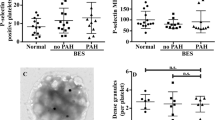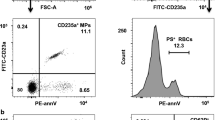Abstract
The presence of elevated numbers of circulating microparticles (MPs) has been hypothesized to be responsible for the occurrence of thromboembolic events (TEEs) in thalassemic patients. Our aim is to evaluate the presence and the thrombotic risk of circulating MPs in thalassemia patients and to determine the difference in MPs between β-thalassemia major (β-TM) and thalassemia intermedia (TI). The percentage of the annexin-labeled MPs, platelet-derived MPs (PMPs), erythrocyte-derived MPs (RMPs), and endothelial-derived MPs (EMPs) was measured by flow cytometry, in 87 thalassemia patients (39 β-TM and 48 TI). By multiple regression analysis, we then assessed the various independent risk factors for the occurrence of TEE. The thalassemic patients who experienced TEE had a significantly higher platelet count, higher percentage of annexin-labeled MPs, and higher percentage of PMPs (p value = 0.014, 0.003, and 0.014, respectively). There was no significant difference between β-TM and TI patients at the level of any of the studied MPs. The predictive risk factors for TEE in thalassemic patients were splenectomy, total and direct bilirubin, the RMPs, and the EMPs (OR = 10.07 (CI = 3.7–27.1), 4.3 (CI = 2.1–8.7), 1.4 (CI = 1.5–6.2), 1.6 (CI = 1.1–2.2), 3.0 (CI = 1.9–4.9), respectively). In conclusion, the elevated numbers of circulating MPs is a risk factor for the TEE in thalassemia patients.

Similar content being viewed by others
References
Martin A, Thompson AA (2013). Thalassemias. Pediatr Clin North Am 60:138391
Owens AP 3rd, Mackman N (2011) Microparticles in hemostasis and thrombosis. Circ Res 108:1284–1297
Flaumenhaft R (2006) Formation and fate of platelet microparticles. Blood Cells Mol Dis 36:182–187
Shet AS, Aras O, Gupta K, Hass MJ, Rausch DJ, Saba N, Koopmeiners L (2003) Sickle blood contains tissue factor-positive microparticles derived from endothelial cells and monocytes. Blood 102:2678–2683
Van Beers EJ, Schaap MC, Berckmans RJ, Nieuwland R, Sturk A, van Doormaat FF, Meijers JC, Biemond BJ, CURAMA study group (2009) Circulating erythrocyte-derived microparticles are associated with coagulation activation in sickle cell disease. Haematologica 94:1513–1519
Hugel B, Martinez MC, Kunzelmann C, Freyssinet JM (2005) Membrane microparticles: two sides of the coin. Physiology (Bethesda) 20:22–27
Pattanapanyasat K, Gonwong S, Chaichompoo P, Noulsri E, Lerdwana S, Sukapirom K, Siritanaratkul N, Fucharoen S (2007) Activated platelet-derived microparticles in thalassaemia. Br J Haematol 136:462–471
Nantakomol D, Palasuwan A, Chaowanathikhom M, Soogarun S, Imwong M (2012) Red cell and platelet-derived microparticles are increased in G6PD-deficient subjects. Eur J Haematol 89(5):423–429
Dey-Hazra E, Hertel B, Kirsch T, Woywodt A, Lovric S, Haller H, Haubitz M, Erdbruegger U (2010) Detection of circulating microparticles by flow cytometry: influence of centrifugation, filtration of buffer, and freezing. Vasc Health Risk Manag 6(6):1125–1133
Elsayh KI, Zahran AM, El-Abaseri TB, Mohamed AO, El-Metwally TH (2014) Hypoxia biomarkers, oxidative stress, and circulating microparticles in pediatric patients with thalassemia in upper Egypt. Clin Appl Thromb Hemost 20(5):536–545
Eldor A, Rachmilewitz EA (2012) The hypercoagulable state in thalassemia. Blood 1(99):36–43
Pazgal I, Inbar E, Cohen M, Shilberg O, Stark P (2016) High indicence of silent cerebral infarcts in adult patients with beta thalassemia major. Throm Res 144:119–122
Musallam KM, Taher AT, Karimi M, Rachmilewitz EA (2012) Cerebral infarction in beta thalassemia intermedia: breaking the silence. Thromb Res 130:695–702
Karimi M, Toosi F, Haghpanah S, Pishdad P, Avazpour A, Rachmilewitz EA (2016) The frequency of silent cerabral ischemia in patients with transfusion dependent beta thalassemia major. Accepted for publication in Annals of Hematology 95:135–139
Cappellini MD, Robbiolo L, Bottasso BM, Coppola R, Fiorelli G, Mannucci AP (2000) Venous thromboembolism and hypercoagulability in splenectomized patients with thalassaemia intermedia. Br J Haematol 111(2):467–473
VanWijk MJ, VanBavel E, Sturk A, Nieuwland R (2003) Microparticles in cardiovascular diseases. Cardiovasc Res 59:277–287
Tantawy AA, Adly AA, Ismail EA, Habeeb NM, Farouk A (2013) Circulating platelet and erythrocyte microparticles in young children and adolescents with sickle cell disease: relation to cardiovascular complications. Platelets 24(8):605–614
Habib A, Kunzelmann C, Shamseddeen W, Zobairi F, Freyssinet JM, Taher A (2008) Elevated levels of circulating procoagulant micro-particles in patients with beta-thalassemia intermedia. Haematologica 93(6):941–942
Taher A, Musallam KM, Karimi M, El-Beshlawy A, Belhoul K, Daar S, Saned MS, El-Chafic AH, Fasulo MR, Cappellini MD (2010) Overview on practices in thalassemia intermedia management aiming for lowering complication rates across a region of endemicity: the OPTIMAL CARE study. Blood 115:1886–1892
Cappellini MD, Grespi E, Cassinerio E, Bignamini D, Fiorelli G (2005) Coagulation and splenectomy: an overview. Ann N Y Acad Sci 1054:317–324
Atichartakarn V, Angchaisuksiri P, Aryurachai K, Onpun S, Chuncharunee S, Thakkinstian A, Atamasirikul K (2002) Relationship between hypercoagulable state and erythrocyte phosphatidylserine exposure in splenectomized haemoglobin E/beta-thalassaemic patients. Br J Haematol 118(3):893–898
Cappellini MD, Motta I, Musallam KM, Taher A (2010) Redefining thalassemia as a hypercoagulable state. Ann N Y Acad Sci 1202:231–236
Zalloua PA, Shbaklo H, Mourad YA, Koussa S, Taher A (2003) Incidence of thromboembolic events in Lebanese thalassemia intermedia patients. Thromb Haemost 89(4):767–768
Balla J, Vercellotti GM, Nath K, Yachie A, Nagy E, Eaton JW, Balla G (2003) Haem, haem oxygenase and ferritin in vascular endothelial cell injury. Nephrol Dial Transplant 18(5):8–12
Malyutin Z, Shai E, Dana M, Rachmilewitz E, Fibach E, VaronD (2012) Shorter carotid artery occlusion in a thalassemic mouse model: a potential role for oxidative stress affecting both RBCs and platelets. J Thromb Haemost 11:66–67
Author information
Authors and Affiliations
Corresponding author
Ethics declarations
Patients and/or their guardians gave their informed consent, and the Institutional Review Board (IRB) approved the study.
Financial relationship:
This research had no financial support.
Conflict of interest
The authors declare that they have no conflict of interest.
Rights and permissions
About this article
Cite this article
Youssry, I., Soliman, N., Ghamrawy, M. et al. Circulating microparticles and the risk of thromboembolic events in Egyptian beta thalassemia patients. Ann Hematol 96, 597–603 (2017). https://doi.org/10.1007/s00277-017-2925-x
Received:
Accepted:
Published:
Issue Date:
DOI: https://doi.org/10.1007/s00277-017-2925-x




